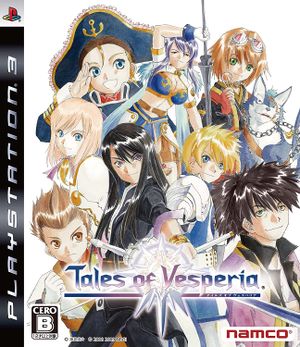No edit summary |
HerrHulaHoop (talk | contribs) (Fixed missing close bracket. Also, shortened write-up.) |
||
| Line 8: | Line 8: | ||
|genre = Action, Role-playing | |genre = Action, Role-playing | ||
|modes = Single-player, Co-op <!-- Choose all relevant options: Single-player, Co-op, Multiplayer --> | |modes = Single-player, Co-op <!-- Choose all relevant options: Single-player, Co-op, Multiplayer --> | ||
|gameid = {{gameid|id=BLJS10053|ird= | |gameid = {{gameid|id=BLJS10053|ird=Yes}} | ||
}} | |||
'''''Tales of Vesperia''''' is | '''''Tales of Vesperia''''' is the tenth mainline entry in the Tales series and is set in the world of Terca Lumireis, which uses an energy source called blastia for all its needs, including creating protective barriers around its cities. The story focuses on Yuri Lowell, a former Imperial soldier who forms a guild called Brave Vesperia to aid Estelle, a noble woman he encounters on a mission. As they explore the world, Brave Vesperia are challenged by factions who have different plans related to the abuse of blastia resources, and Yuri is forced to confront his friend and former comrade Flynn. | ||
The game is set in a fantasy world featuring three-dimensional environments and characters. The game's environments are split into two types. On the field map, the main characters navigate reduced-scale environments. A compass and mini-map are displayed, along with towns, other named locations, and enemy icons. Striking an enemy icon triggers a battle, while interacting with a town causes the party to enter it. In battle and towns or similar locations, characters move around environments built on a lifelike scale relative to the human characters. | |||
The PlayStation 3 version of the game has two additional playable characters, new quests, new mini-games, redesigned areas, new artes, additional skits and full voice acting, amongst other improvements and changes over the Xbox 360 original release. | The PlayStation 3 version of the game has two additional playable characters, new quests, new mini-games, redesigned areas, new artes, additional skits and full voice acting, amongst other improvements and changes over the Xbox 360 original release. This version of the game was released exclusively in Japanese, however there is a fan translation available and is compatible with RPCS3. | ||
This version of the game was released exclusively in Japanese, however there is a fan translation available and is compatible with RPCS3. | |||
==Configuration== | ==Configuration== | ||
Revision as of 19:54, 2 October 2021
| Tales of Vesperia | |
|---|---|

| |
| Developer(s) | Namco Tales Studio |
| Publisher(s) | Bandai Namco Games |
| Series | Tales |
| Release date(s) | JP September 17, 2009 |
| Release type | Multi-platform |
| Genre(s) | Action, Role-playing |
| Mode(s) | Single-player, Co-op |
| GameID(s) | BLJS10053 (IRD) |
| Quick links | Check Compatibility Open Issues Search Google Wikipedia Page |
Tales of Vesperia is the tenth mainline entry in the Tales series and is set in the world of Terca Lumireis, which uses an energy source called blastia for all its needs, including creating protective barriers around its cities. The story focuses on Yuri Lowell, a former Imperial soldier who forms a guild called Brave Vesperia to aid Estelle, a noble woman he encounters on a mission. As they explore the world, Brave Vesperia are challenged by factions who have different plans related to the abuse of blastia resources, and Yuri is forced to confront his friend and former comrade Flynn.
The game is set in a fantasy world featuring three-dimensional environments and characters. The game's environments are split into two types. On the field map, the main characters navigate reduced-scale environments. A compass and mini-map are displayed, along with towns, other named locations, and enemy icons. Striking an enemy icon triggers a battle, while interacting with a town causes the party to enter it. In battle and towns or similar locations, characters move around environments built on a lifelike scale relative to the human characters.
The PlayStation 3 version of the game has two additional playable characters, new quests, new mini-games, redesigned areas, new artes, additional skits and full voice acting, amongst other improvements and changes over the Xbox 360 original release. This version of the game was released exclusively in Japanese, however there is a fan translation available and is compatible with RPCS3.
Configuration
No options that deviate from RPCS3's default settings are recommended for this title.
Known Issues
There are no reported issues with this title.